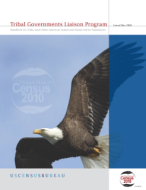
An official website of the United States government
Here’s how you know
Official websites use .gov
A .gov website belongs to an official government organization in the United States.
Secure .gov websites use HTTPS
A lock (
) or https:// means you’ve safely connected to the .gov website. Share sensitive information only on official, secure websites.
-
//
- Census.gov /
- Publications /
- Tribal Governments Liaison Program Handbook
Tribal Governments Liaison Program: Handbook for Tribes and Urban American Indian and Alaska Native Populations
Tribal Governments Liaison Program: Handbook for Tribes and Urban American Indian and Alaska Native Populations
Introduction
Welcome to the Tribal Governments Liaison Program, a key component of the U.S. Census Bureau’s 2010 American Indian and Alaska Native (AIAN) Program. This program was created to enhance the partnership between the Census Bureau and federally recognized tribal governments. This handbook provides guidance to assist Tribal Governments Liaisons in promoting the 2010 Census within their community.
This Tribal Governments Liaison Program Handbook includes some brief information about past censuses and the confidentiality of census information; it then discusses the Tribal Governments Liaison Program and, in particular, provides suggested activities for Tribal Governments Liaisons.
The Census Bureau recognizes that, as sovereign nations, tribes will choose to implement only those activities that are most appropriate for their individual communities. To supplement this handbook, Tribal Governments Liaisons will have the opportunity to participate in training provided by Regional Census Bureau staff.
Ultimately, tribes and the Census Bureau share a common objective for the 2010 Census: to obtain an accurate and complete census count of each American Indian and Alaska Native no matter where they live. A successful 2010 Census will provide solid information that each sovereign tribal government can use to make judgments for meeting the challenges of serving succeeding generations of AIANs.
Although this handbook was developed for the Tribal Governments Liaison Program, its guidelines and suggested activities are also meant to be relevant for American Indian and Alaska Native partnerships in urban and rural communities. The 2000 Census revealed that approximately 60-64% of the AIAN population resided in urban communities living off-reservation or outside tribal jurisdictional boundaries. In most cases, tribal governments do not directly serve them. This significant population is comprised of federally recognized, state-recognized, and nonrecognized AIAN individuals and families. They are served by urban community centers, inter-tribal associations, churches, and nonprofit organizations. This population can be found in all facets of urban and rural areas, including the military, schools, factories, prisons, farms, offshore oilrigs, and mines. In some cases they may be persons experiencing homelessness.
Certain protocols and procedures applicable to tribal governments may not be relevant to these populations. However, this handbook provides valuable information to strengthen all partnerships in achieving the goal of a complete and accurate census count for the AIAN population.
Share
Related Information
Some content on this site is available in several different electronic formats. Some of the files may require a plug-in or additional software to view.
 Yes
Yes
 No
NoComments or suggestions?


Top

